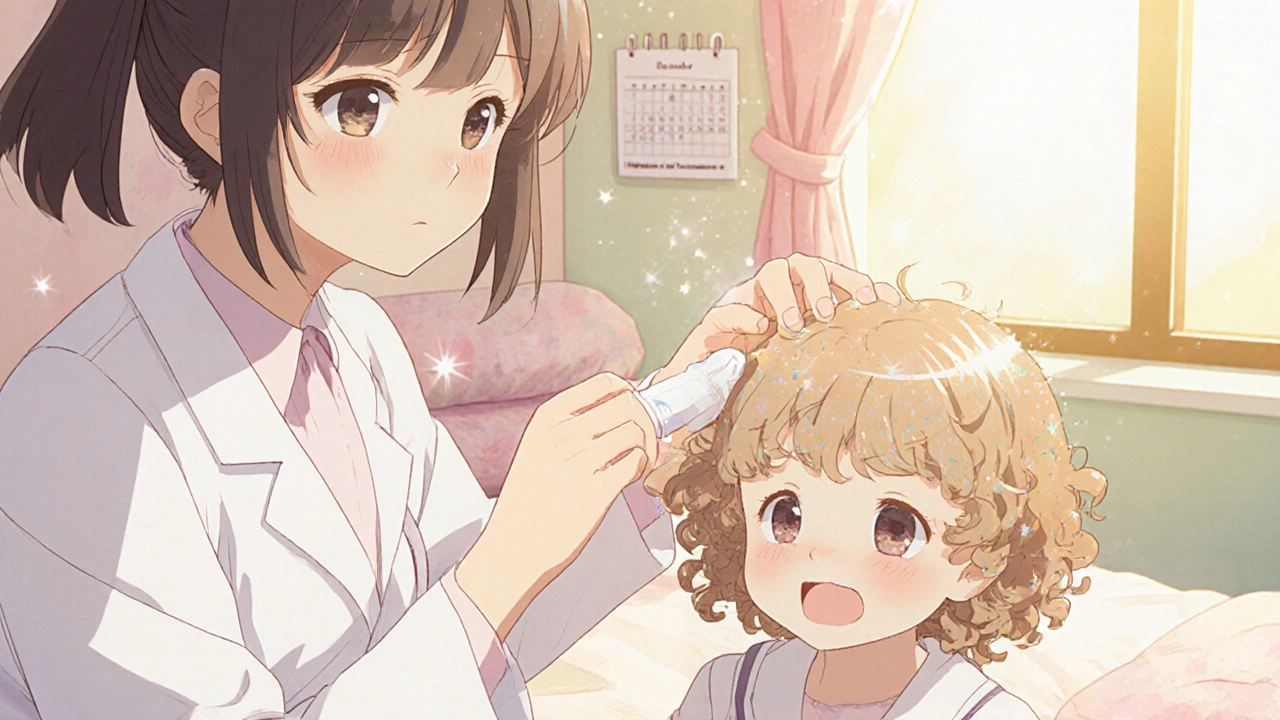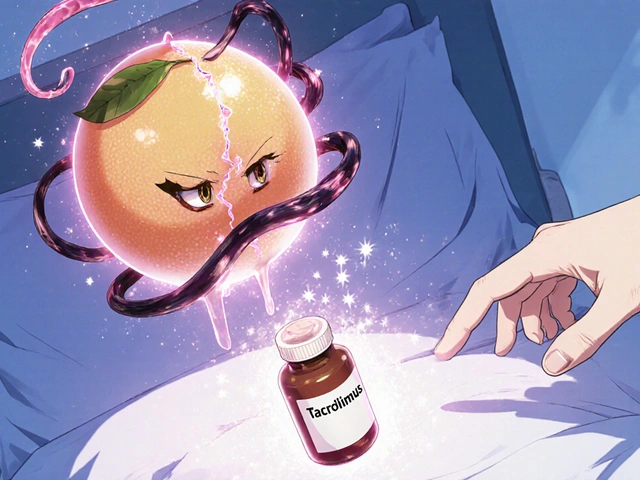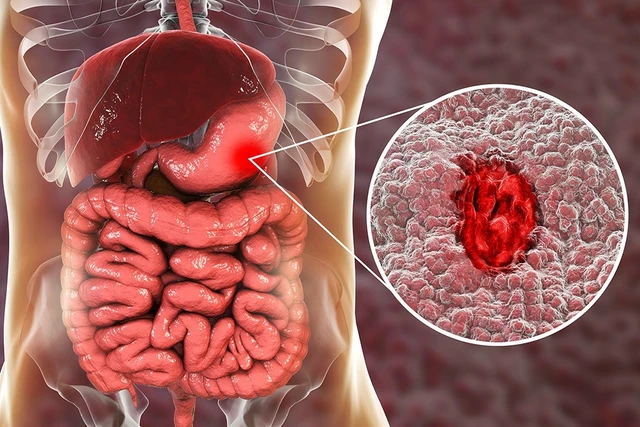Permethrin Dilution Calculator
Safe Application Guide
This calculator helps determine proper permethrin concentrations based on FDA guidelines and article research. Always follow product instructions and consult a healthcare provider.
Key Safety Points
For head lice treatment
Human-grade unsafe for pets
For mosquito repellent
When you hear about Permethrin is a synthetic pyrethroid insecticide used in both medical and agricultural settings, the first thought is often a mix of relief and worry. People love its quick action on head lice, yet fear it might poison them or their kids. This article pulls apart the most common Permethrin myths and gives you the facts you need to decide whether it’s right for you.
What Exactly Is Permethrin?
At its core, permethrin belongs to the Pyrethroids family, a class of chemicals modeled after the natural pyrethrins found in chrysanthemum flowers. The compound works by disrupting the nervous system of insects, causing rapid paralysis and death. In medicine, it’s formulated as a 1% cream or lotion for treating head lice and scabies, while in agriculture it’s sprayed on crops, livestock, and even outdoor spaces to control mosquitoes and ticks.
Where The Confusion Starts: The Top Five Myths
- Myth 1: Permethrin is a poison that can cause cancer in humans.
- Myth 2: A single treatment will eliminate all lice and prevent reinfestation forever.
- Myth 3: It’s unsafe for pregnant or breastfeeding mothers.
- Myth 4: Permethrin can be used on pets without any risk.
- Myth 5: All over‑the‑counter lice shampoos contain the same amount of permethrin.
Below each myth, you’ll find what science actually says.
Fact‑Check Table
| Myth | Fact |
|---|---|
| Permethrin is a human carcinogen. | Regulatory agencies such as the EPA and the World Health Organization classify permethrin as unlikely to cause cancer at the doses used for lice treatment. |
| One application wipes out every single louse for good. | Permethrin kills live lice but not their eggs. A second treatment 7-10 days later is recommended to catch any newly hatched nymphs. |
| Pregnant women should never use it. | Topical 1% permethrin is considered low risk in pregnancy; doctors may still advise caution and prefer alternative treatments if concerns remain. |
| It’s safe to spray pets with the same product used for humans. | Veterinary‑specific formulations exist. Human‑grade permethrin can irritate animal skin and should not be used on pets. |
| All lice shampoos have identical strength. | Concentrations vary (1% cream, 0.5% shampoo, etc.). Always read the label; lower concentrations may need longer contact time. |

Safety Profile: What the Research Shows
Most adverse reactions are mild skin irritation or a temporary burning sensation. Serious systemic effects like neurotoxicity are extremely rare and usually linked to accidental ingestion or massive over‑exposure, not the brief topical use recommended for lice. A 2023 review in the Journal of Clinical Toxicology examined over 2,000 cases and found only 0.3% involved severe outcomes, and those were tied to misuse.
Key safety points:
- Apply only to dry hair and scalp; avoid broken skin.
- Wash hands thoroughly after application.
- Do not combine with other hair‑care products (conditioners, oils) for at least 24 hours.
Resistance: Why Correct Use Matters
Overuse can lead to Resistance in head‑lice populations. Studies in the UK (2022) reported a 12% rise in permethrin‑resistant lice after two consecutive years of blanket treatments. The takeaway? Use permethrin only when confirmed lice are present, follow the dosing schedule, and consider rotating with a different class (e.g., spinosad) if resistance is suspected.

Choosing the Right Product: Practical Tips
- Check the concentration. Look for 1% permethrin cream or lotion for lice; lower percentages are meant for insects like mosquitoes.
- Read the expiration date. Potency declines over time, especially in humid climates.
- Follow the age guidelines. Some products are labeled for children 6 months and older, while others start at 2 years.
- Consider the formulation. Creams stay on the scalp longer than shampoos, which may be easier for a quick wash‑out.
- Buy from reputable sources. Pharmacy‑filled prescriptions and respected over‑the‑counter brands reduce the risk of counterfeit products.
Frequently Asked Questions
Is permethrin safe for toddlers?
The 1% lotion is approved for children as young as 6 months when used exactly as directed. Keep the product away from eyes and mouth, and wash hands after application.
Can permethrin be used to prevent mosquito bites?
Yes, permethrin‑treated clothing and bed nets are effective against mosquitoes. However, the concentration for this use is much higher than the 1% cream for lice, and it should not be applied directly to skin.
What should I do if I experience a rash after using permethrin?
Rinse the area with mild soap and cool water. Over‑the‑counter hydrocortisone can soothe mild irritation. If the rash spreads or is accompanied by swelling, seek medical advice.
Do I need to treat the entire household?
Only those who have confirmed lice need treatment. Clean bedding, hats, and hair brushes in hot water (130 °F/54 °C) to prevent re‑infestation.
Can I use permethrin on my dog?
No. Human‑grade permethrin can be toxic to dogs and cats. Use products specifically labeled for veterinary use.
Bottom Line
Permethrin is a powerful tool when used correctly. It’s not a universal poison, nor is it a one‑shot miracle. Understanding its proper concentration, application timing, and safety limits lets you reap its benefits without unnecessary worry.





Sunil Yathakula
Hey folks, I totally get the worry about permethrin – it feels like a gamble using any chemical on kiddos, but the data shows it’s pretty safe when you follow the label. Just make sure the hair is dry and avoid broken skin, then you’ll be good. If you’re nervous, a quick chat with your pediatrician can clear it up fast. Stay chill and keep the scalp clean!
sravya rudraraju
Permethrin, as outlined in the article, occupies a nuanced position within both medical and agricultural domains, necessitating a comprehensive appreciation of its pharmacodynamics and toxicological profile. The synthesis of pyrethroid analogues, derived from chrysanthemum-derived pyrethrins, bestows upon permethrin a heightened potency against arthropod nervous systems while maintaining a relatively low mammalian toxicity threshold. Empirical evidence, such as the 2023 Journal of Clinical Toxicology review, underscores a minuscule incidence of severe adverse events, thereby reinforcing its suitability for topical application in pediatric populations when employed according to established guidelines. Nevertheless, the propensity for resistance development, as documented in recent United Kingdom surveillance studies, mandates prudent stewardship; indiscriminate or prophylactic usage may inadvertently precipitate a selection pressure that culminates in resistant louse phenotypes, rendering standard therapeutic regimens less effective. Consequently, clinicians and caregivers alike should prioritize accurate diagnosis prior to initiating treatment, enforce the recommended interval of 7–10 days between applications to address emergent nymphs, and consider alternative classes, such as spinosad, should resistance be suspected. Moreover, the distinction between human-grade and veterinary formulations cannot be overstated, given the documented dermal irritation and systemic toxicity risks associated with cross‑species misuse. In sum, while permethrin remains a valuable instrument within the anti‑lice armamentarium, its optimal efficacy and safety are contingent upon informed, judicious application that respects both the pharmacological specificity and the evolving epidemiological landscape.
Nicole Boyle
From a biotech perspective, the active moiety of permethrin interferes with voltage‑gated sodium channels in insects, causing hyperexcitation and paralysis. Human dermal absorption is minimal, which explains the low systemic toxicity observed in clinical trials. That said, when you apply the lotion, ensure the scalp is free of cuts; any breach could increase local irritation. Also, remember that the FDA’s OTC monograph lists permissible concentrations, so a 1% formulation is the gold standard for lice.
Thokchom Imosana
Look, the mainstream narrative hides the fact that big pharma pushes permethrin to keep us dependent on chemical fixes, while natural alternatives are sidelined. The CDC’s vague safety claims are just smoke; you never hear about the subtle endocrine disruption studies that get buried. Question everything and demand transparency before you slather anything on your kid’s scalp.
ashanti barrett
Let me be clear: if you see a rash after using permethrin, rinse immediately, apply a mild hydrocortisone cream, and seek medical attention if it spreads. Don’t ignore skin reactions; they’re your body’s alarm system.
Leo Chan
Guys, I’ve tried the 1% cream on my kids and it works like a charm. Just remember to keep the hair dry before applying and avoid using conditioner for a day after. It’s a hassle-free win.
jagdish soni
yeah the cream works
Latasha Becker
While the resistance data is valid, the article glosses over the socioeconomic factors that drive over‑use-people in low‑income areas may lack access to alternative treatments and thus rely heavily on permethrin, inadvertently accelerating resistance.
parth gajjar
Honestly, the whole “permethrin is unsafe for pets” thing is overblown. My neighbor’s dog sniffed the bottle once and was fine. You just need to wash your hands.
Maridel Frey
For those seeking clarity, consult the EPA’s pesticide fact sheet, which delineates permissible exposure limits and highlights the distinction between topical and environmental applications.
Madhav Dasari
Remember, a second treatment isn’t just a suggestion-it's essential to catch any nymphs that hatch after the first round. Skipping it often leads to a comeback.
DHARMENDER BHATHAVAR
Applying permethrin correctly is simple: dry hair, apply lotion, leave for 10 minutes, then rinse. Follow the label.
Kevin Sheehan
Philosophically, our reliance on chemical solutions reflects a broader disengagement from holistic health practices. Yet, when used responsibly, permethrin embodies a pragmatic compromise between efficacy and safety.
Jay Kay
Sure, permethrin works, but don’t let the pharma hype blind you-always read the fine print and consider non‑chemical options too.